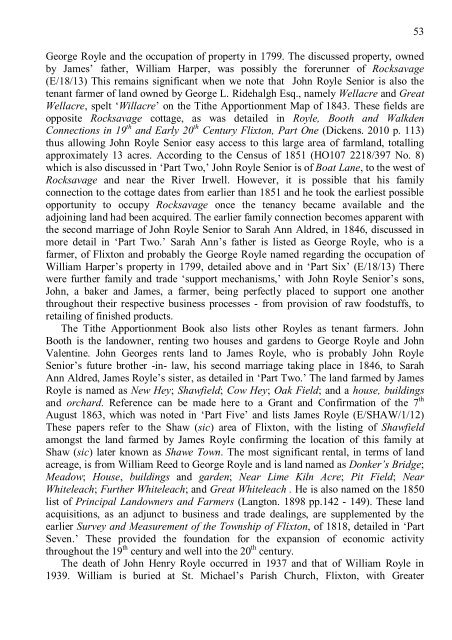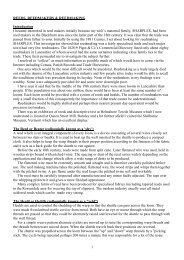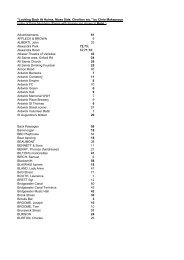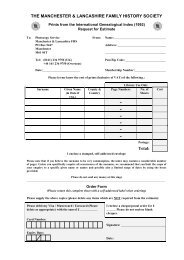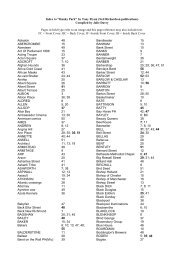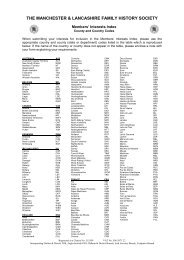The Roles of William and John Henry Royle in the Development of ...
The Roles of William and John Henry Royle in the Development of ...
The Roles of William and John Henry Royle in the Development of ...
Create successful ePaper yourself
Turn your PDF publications into a flip-book with our unique Google optimized e-Paper software.
George <strong>Royle</strong> <strong>and</strong> <strong>the</strong> occupation <strong>of</strong> property <strong>in</strong> 1799. <strong>The</strong> discussed property, owned<br />
by James’ fa<strong>the</strong>r, <strong>William</strong> Harper, was possibly <strong>the</strong> forerunner <strong>of</strong> Rocksavage<br />
(E/18/13) This rema<strong>in</strong>s significant when we note that <strong>John</strong> <strong>Royle</strong> Senior is also <strong>the</strong><br />
tenant farmer <strong>of</strong> l<strong>and</strong> owned by George L. Ridehalgh Esq., namely Wellacre <strong>and</strong> Great<br />
Wellacre, spelt ‘Willacre’ on <strong>the</strong> Ti<strong>the</strong> Apportionment Map <strong>of</strong> 1843. <strong>The</strong>se fields are<br />
opposite Rocksavage cottage, as was detailed <strong>in</strong> <strong>Royle</strong>, Booth <strong>and</strong> Walkden<br />
Connections <strong>in</strong> 19 th <strong>and</strong> Early 20 th Century Flixton, Part One (Dickens. 2010 p. 113)<br />
thus allow<strong>in</strong>g <strong>John</strong> <strong>Royle</strong> Senior easy access to this large area <strong>of</strong> farml<strong>and</strong>, totall<strong>in</strong>g<br />
approximately 13 acres. Accord<strong>in</strong>g to <strong>the</strong> Census <strong>of</strong> 1851 (HO107 2218/397 No. 8)<br />
which is also discussed <strong>in</strong> ‘Part Two,’ <strong>John</strong> <strong>Royle</strong> Senior is <strong>of</strong> Boat Lane, to <strong>the</strong> west <strong>of</strong><br />
Rocksavage <strong>and</strong> near <strong>the</strong> River Irwell. However, it is possible that his family<br />
connection to <strong>the</strong> cottage dates from earlier than 1851 <strong>and</strong> he took <strong>the</strong> earliest possible<br />
opportunity to occupy Rocksavage once <strong>the</strong> tenancy became available <strong>and</strong> <strong>the</strong><br />
adjo<strong>in</strong><strong>in</strong>g l<strong>and</strong> had been acquired. <strong>The</strong> earlier family connection becomes apparent with<br />
<strong>the</strong> second marriage <strong>of</strong> <strong>John</strong> <strong>Royle</strong> Senior to Sarah Ann Aldred, <strong>in</strong> 1846, discussed <strong>in</strong><br />
more detail <strong>in</strong> ‘Part Two.’ Sarah Ann’s fa<strong>the</strong>r is listed as George <strong>Royle</strong>, who is a<br />
farmer, <strong>of</strong> Flixton <strong>and</strong> probably <strong>the</strong> George <strong>Royle</strong> named regard<strong>in</strong>g <strong>the</strong> occupation <strong>of</strong><br />
<strong>William</strong> Harper’s property <strong>in</strong> 1799, detailed above <strong>and</strong> <strong>in</strong> ‘Part Six’ (E/18/13) <strong>The</strong>re<br />
were fur<strong>the</strong>r family <strong>and</strong> trade ‘support mechanisms,’ with <strong>John</strong> <strong>Royle</strong> Senior’s sons,<br />
<strong>John</strong>, a baker <strong>and</strong> James, a farmer, be<strong>in</strong>g perfectly placed to support one ano<strong>the</strong>r<br />
throughout <strong>the</strong>ir respective bus<strong>in</strong>ess processes - from provision <strong>of</strong> raw foodstuffs, to<br />
retail<strong>in</strong>g <strong>of</strong> f<strong>in</strong>ished products.<br />
<strong>The</strong> Ti<strong>the</strong> Apportionment Book also lists o<strong>the</strong>r <strong>Royle</strong>s as tenant farmers. <strong>John</strong><br />
Booth is <strong>the</strong> l<strong>and</strong>owner, rent<strong>in</strong>g two houses <strong>and</strong> gardens to George <strong>Royle</strong> <strong>and</strong> <strong>John</strong><br />
Valent<strong>in</strong>e. <strong>John</strong> Georges rents l<strong>and</strong> to James <strong>Royle</strong>, who is probably <strong>John</strong> <strong>Royle</strong><br />
Senior’s future bro<strong>the</strong>r -<strong>in</strong>- law, his second marriage tak<strong>in</strong>g place <strong>in</strong> 1846, to Sarah<br />
Ann Aldred, James <strong>Royle</strong>’s sister, as detailed <strong>in</strong> ‘Part Two.’ <strong>The</strong> l<strong>and</strong> farmed by James<br />
<strong>Royle</strong> is named as New Hey; Shawfield; Cow Hey; Oak Field; <strong>and</strong> a house, build<strong>in</strong>gs<br />
<strong>and</strong> orchard. Reference can be made here to a Grant <strong>and</strong> Confirmation <strong>of</strong> <strong>the</strong> 7 th<br />
August 1863, which was noted <strong>in</strong> ‘Part Five’ <strong>and</strong> lists James <strong>Royle</strong> (E/SHAW/1/12)<br />
<strong>The</strong>se papers refer to <strong>the</strong> Shaw (sic) area <strong>of</strong> Flixton, with <strong>the</strong> list<strong>in</strong>g <strong>of</strong> Shawfield<br />
amongst <strong>the</strong> l<strong>and</strong> farmed by James <strong>Royle</strong> confirm<strong>in</strong>g <strong>the</strong> location <strong>of</strong> this family at<br />
Shaw (sic) later known as Shawe Town. <strong>The</strong> most significant rental, <strong>in</strong> terms <strong>of</strong> l<strong>and</strong><br />
acreage, is from <strong>William</strong> Reed to George <strong>Royle</strong> <strong>and</strong> is l<strong>and</strong> named as Donker’s Bridge;<br />
Meadow; House, build<strong>in</strong>gs <strong>and</strong> garden; Near Lime Kiln Acre; Pit Field; Near<br />
Whiteleach; Fur<strong>the</strong>r Whiteleach; <strong>and</strong> Great Whiteleach . He is also named on <strong>the</strong> 1850<br />
list <strong>of</strong> Pr<strong>in</strong>cipal L<strong>and</strong>owners <strong>and</strong> Farmers (Langton. 1898 pp.142 - 149). <strong>The</strong>se l<strong>and</strong><br />
acquisitions, as an adjunct to bus<strong>in</strong>ess <strong>and</strong> trade deal<strong>in</strong>gs, are supplemented by <strong>the</strong><br />
earlier Survey <strong>and</strong> Measurement <strong>of</strong> <strong>the</strong> Township <strong>of</strong> Flixton, <strong>of</strong> 1818, detailed <strong>in</strong> ‘Part<br />
Seven.’ <strong>The</strong>se provided <strong>the</strong> foundation for <strong>the</strong> expansion <strong>of</strong> economic activity<br />
throughout <strong>the</strong> 19 th century <strong>and</strong> well <strong>in</strong>to <strong>the</strong> 20 th century.<br />
<strong>The</strong> death <strong>of</strong> <strong>John</strong> <strong>Henry</strong> <strong>Royle</strong> occurred <strong>in</strong> 1937 <strong>and</strong> that <strong>of</strong> <strong>William</strong> <strong>Royle</strong> <strong>in</strong><br />
1939. <strong>William</strong> is buried at St. Michael’s Parish Church, Flixton, with Greater<br />
53


